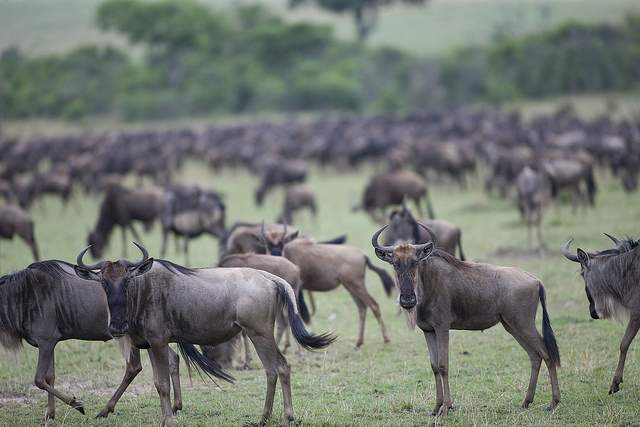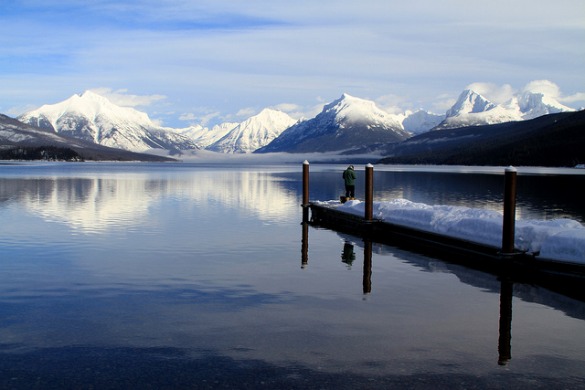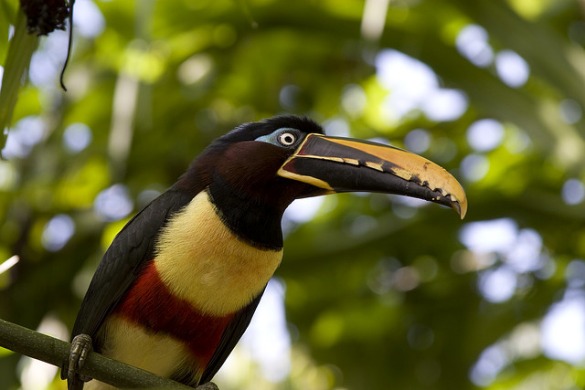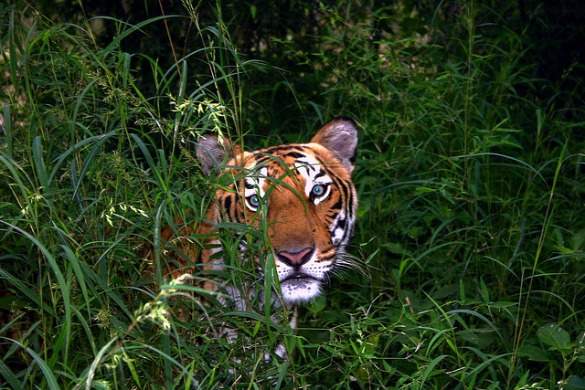Our “Sustainable Travel” series is sponsored by Global Basecamps. Global Basecamps is specialty travel company that helps independent travelers research and book locally owned boutique hotels, off-the-beaten path lodges and multi-day excursions all over the world. Whether hiking the Inca Trail, experiencing a traditional Japanese Ryokan, or relaxing on the beaches of Thailand, Global Basecamps specializes in designing completely customized itineraries to meet each travelers specific priorities and match their travel style.
Some of the most intriguing natural phenomena on the planet are some of the most sensitive and fleeting, and threats of climate change, endangered species, deforestation, and other human abuses of nature add an element of urgency to outdoor travel experiences worldwide. Environmental tourism is one way to show your appreciation for the Earth’s wonders, and even help protect them; but at the same time, your actions as a traveler sometimes have unintended negative impacts as well. it’s the Catch-22 of travel: how to see these endangered animals and environments without contributing to their demise? Here are six examples of at-risk places to visit, and ideas for how you can do so responsibly.
The Great Migration in Tanzania
1.5 million wildebeest are joined by 200,000 zebras and 500,000 gazelles to make up the biggest moving group of wildlife in the world. The ongoing Great Migration covers a 500-kilometer clockwise loop in Tanzania’s Serengeti National Park, as the herds make their rounds according to the seasonal availability of grasses to feed on. Carnivores like lions and hyenas follow the massive group of herbivores to satisfy their own feeding habits.
In a shocking threat to this annual phenomenon, the Tanzanian government plans to build a two-lane highway that would increase accessibility and economic opportunities for locals but would cut through the famous route of the Serengeti wildlife. The highway would result in interruption of the migrating animals, pollution and danger from traffic, increased threats of poaching and human settlement, and even the introduction of invasive plant species. Visit Serengeti Watch to learn more about the issue and see a possible alternative route for the proposed highway.
If you’d like to go see the Great Migration, be sure to opt for ecotourism options in Tanzania and the Serengeti, especially those that support the local Maasai and Sukuma communities. Indigenous people who live in and around the Serengeti need sustainable ways to make a living, and ecotourism is one growing source of livelihood, so the proposed highway project would not only affect the wildlife there, but the economic benefits of tourism; if Tanzania loses its claim to the last remaining large-scale land migration on Earth, it would also lose a large part of its appeal as a travel destination.
>> Discover seven places for an affordable safari and look for airfare to Tanzania
Glacier National Park
Glaciers, gracing mountain ranges on every continent except Australia, make up the largest source of freshwater on the planet. Their formation, movement, and melting patterns are essential to the water cycle and seasonal changes in ecosystems. They are especially sensitive to global climate change, as fluctuations in temperature and precipitation can put them out of equilibrium, causing dramatic decreases in glacial mass.
Scientists predict that by 2020 or 2030, all the glaciers found in the Rocky Mountains in Glacier National Park will be lost due to climate change, if current trends continue. The largest glaciers of Montana have already retreated to one-third the area they covered in 1850, when studies began.
If you want to trek the Rockies to spot these icy reserves, be sure to adhere to strict Leave No Trace stewardship guidelines, paying attention to how your camping, hiking, waste disposal, and campfire methods could affect the environment. But keep in mind that your behavior while in the wilderness is not nearly enough to save the glaciers. Minimizing your daily ecological footprint during your regular life will have a greater overall effect.
>> Check out ten tips for more eco-friendly travel
Icebergs of Alaska
Glaciers and icebergs go hand in hand, since icebergs are usually large chunks of freshwater glaciers that fall into the ocean or lakes. Icebergs play a crucial role in the ocean’s salinity and circulation, so when climate change causes icebergs to break off and melt at higher rates, it can disturb the way heat and water streams move around the entire planet. Scientists are still trying to determine the far-reaching effects of these massive structures.
The Alaskan coast offers some of the most accessible places to see dramatic icebergs, but the sensitive environment there serves as a reminder to keep your travel impact to a minimum. Use Adventure Green Alaska, a sustainable tourism certification, to help you choose responsible companies and activities on your trip, and try to opt for low-emission activities such as kayaking (rather than cruises).
>> Learn about the best sustainable travel experiences
The Amazon Rainforest
The world’s largest and most well known rainforest, the Amazon is home to one-tenth of the species on Earth, and its health is an indicator of the entire planet’s health. Although deforestation rates are not nearly as rapid as they were a few decades ago, the current rates are such that 55% of the forest cover could be wiped out by the year 2030. The single biggest cause of deforestation of the Amazon is clearing land for agriculture—mainly raising cattle and growing soybeans for livestock feed.
To make sure you are not part of the problem when you visit the Amazon, do thorough research to find verified eco-lodges and green tourism companies like the Huaorani Ecolodge in Ecuador, which offers accommodation for up to ten people in five Huaorani-style, palm-thatched cabins an hour’s walk from the community of Quehueri’ono, along the Shiripuno River.
Another thing you can do is support sustainable harvesting of the rainforest’s resources, so that people living in and around the Amazon can make a living without resorting to destructive types of agriculture. Even when you are back at home, you can look for Rainforest Alliance Certified products, including coffee, tea, chocolate, bananas, and mangoes.
>> Find flights to Brazil and check out more Brazil adventure trips into the rainforest and beyond
Wild Tigers of India
There are only about 1,700 tigers left in all of India, a miniscule number compared with the estimated 45,000 tigers that roamed the country a century ago. Massive habitat loss and hunting were responsible for the staggering losses, until serious conservation efforts kicked in during the 1970s. Today, the numbers have stabilized somewhat—the last “tiger census” even reported a slight increase in populations—but illegal poaching for tiger bones, skins, and other parts is still a major threat to the endangered animals.
Even though the focus of tiger tourism has shifted from hunting sprees to wildlife appreciation, it is controversial whether tourism can help with tiger conservation. India has struggled with poorly managed tiger reserves and tourism initiatives, so be careful when selecting your ecotourism experience to spot the elusive cats.
Your best bet is to pick an eco-lodge founded by conservationists. Singinawa Jungle Lodge, the Sarai at Toria, and Reni Pani Jungle Lodge are three examples where the owners are active environmentalists who will discuss the complex issues of tiger conservation with guests. All three lodges boast green building standards, commitment to local communities, and interesting tourist activities other than tracking down and ogling tigers—because unbridled tiger chasing puts unnecessary pressure on the sensitive populations.
>> Read about other endangered species you can see outside of a zoo and find flights to India
Australia’s Great Barrier Reef
Off the northeastern coast of Australia, a series of 2,800 reefs and 900 islands make up the Great Barrier Reef, the world’s largest reef system. It represents a huge chunk of the region’s biodiversity, with 30 species of whales, dolphins, and porpoises, 215 species of birds, 1,500 species of fish, and over 2,000 species of plants.
Coral reefs are especially susceptible to rising water temperatures due to global climate change. “Coral bleaching,” a whitening of the reef, is one sign that temperature changes have affected an area. As of now, only about 5% of the Great Barrier Reef been affected by bleaching, but rates are expected to increase if humans’ negative impact on the environment does not let up. Besides the coral itself, sea turtles, fish, and microorganisms that live in the reef are sensitive to temperature changes; rising temperatures have, for example, caused a noticeable shift in the ratio of male to female turtles born.
In addition to climate change, overfishing and pollution from agriculture and shipping also threaten the reef ecosystem. The Great Barrier Reef Marine Park Authority, which manages most of the reef system, is working to reverse these negative trends, as well as monitor tourism initiatives to ensure they are not compounding damages.
When touring Australia, be sure to select tour operators and accommodations that meet a high level of environmental stewardship. Search the database of Ecotourism Australia certified businesses before your trip. To reduce your impact further, use this Carbon Calculator for travelers to Australia and mind the eco-tips along the way.
>> Book flights to Australia and learn more about diving the Great Barrier Reef
The Global Basecamps Tanzania tours are led by local guides who grew up in the region and are very familiar with the local ecosystems, history, and culture. Additionally, proceeds from each trip directly benefit local communities through various outreach programs. One sustainable travel option within the Amazon Rainforest is to go on a Global Basecamps tour of Colombia, where you’ll journey to the heart of the Amazon and have the opportunity to mingle with the local indigenous peoples and learn first-hand about their traditional customs. Global Basecamps Galapagos Land Safari lets travelers explore the incredible Galapagos Islands as well as the Amazon rainforest, where they will spend time with people native to the rainforest. Global Basecamps India tours emphasizes slow paced travel with a focus on cultural interaction and intimate wildlife encounters. They also offer custom tours in Nepal, Peru, Egypt, Japan and many other countries.
Contact Global Basecamps to enquire about this or other trips.
Photos by: travelswithtwo, glaciernps, Shaun Merritt, Arun Venkatesan, Kamran Mohammady, noaml






